- Home
- The Spring Garden
- Spring Bulbs
Spring Bulbs
Celebrate
the New Season
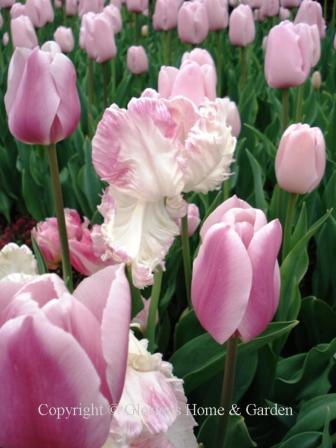 Tulips 'Weber's Parrot' and 'Gabriella'
Tulips 'Weber's Parrot' and 'Gabriella'Spring bulbs are so colorful and joyful after a long winter that I want to extend the season and make them last as long as possible. It's easy to have a sequence of spring bulbs in bloom throughout the season. Start with late winter to early spring bloomers like snowdrops, winter aconites, crocuses and glory-of-the-snow. Then add the main season stars--the daffodils, tulips, hyacinths and fritillarias--and segue into summer with alliums and lilies. Among the narcissus and tulips there are many different species and types to plant that allow us to enjoy these beautiful flowers from February to May.
Alliums (Ornamental Onions)
These are the glamorous diva cousins of our
common culinary onions, leeks, chives, garlic, and shallots, though even the
commonest alliums can be decorative in the vegetable garden if allowed to bloom. But the ornamentals have that special something be it color, height or size
that make them standouts in the spring garden.
They all prefer full sun and well-drained soil on the dry side. Soggy, wet soil can be the death of
them. Use them in combination with
foxgloves, irises, ornamental grasses, roses, and salvias. As the leaves will die down and yellow just
as the blooms appear, it is a good idea to plant among other things to disguise
the dying foliage. And, as a bonus, deer leave them alone.
Allium 'Ambassador,' hybrid ornamental onion, Zones 5-8. Lovely deep purple globes of tightly packed florets up to 7" across with strong stems up to 4' tall. It makes a striking accent rising above other perennials. Other varieties with large globes include A. giganteum, 'Atlas,' 'Gladiator,' 'Globemaster,' and 'Mars.'
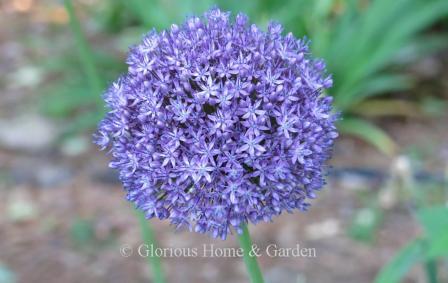 Allium 'Ambassador'
Allium 'Ambassador'Allium amplectens ‘Graceful Beauty,’ Zones 4-8. This is a smaller allium suitable for front of the border or a rock garden. It grows to about 8-12.” The white globes, about 3” diameter, are packed with 6-petaled florets each dotted with purple-tipped stamens appear in late May to early June. Graceful and charming, indeed!
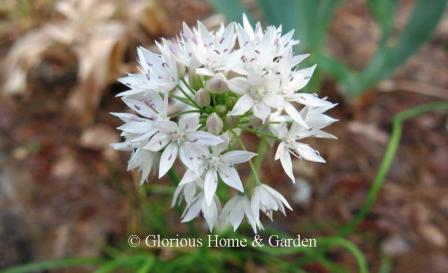 Allium amplectens 'Graceful Beauty'
Allium amplectens 'Graceful Beauty'Allium caeruleum, azure onion, Zones 5-7. Another smaller allium with flowerheads about 1-1 ½,” but the color is gorgeous and unusual for the genus. Plant these in a sunny, well-drained location in a group for best effect. Perfect for rock gardens and containers where they will bloom in late spring. They are also known as Allium azureum.
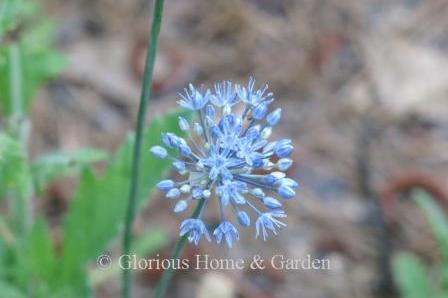 Allium caeruleum
Allium caeruleumAllium christophii, giant allium or star of Persia, Zones 4-8. Star of Persia is an ornamental onion with large (up to 10"), loose airy globes of star-like flowers atop a stem seemingly too short to support the huge head. The leaves emerge in early spring and begin to disappear about the same time as the flowers are blooming so you want to plant something in front of them to hide the decaying leaves though the flower head will remain interesting as it dries.
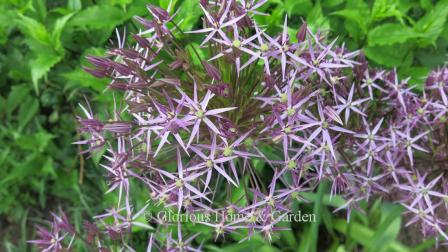 Allium christophii
Allium christophiiAllium ‘Gladiator,’ ornamental onion, Zones 4-8. A cross between A. aflatunense and A.macleanii, ‘Gladiator’ has a large 6” flowerhead composed of many starry flowers in a looser cluster than ‘Ambassador’ or A. giganteum, and can reach 3 to 4’ tall. A paler shade of purple, it makes a good combination with ‘Purple Sensation.’
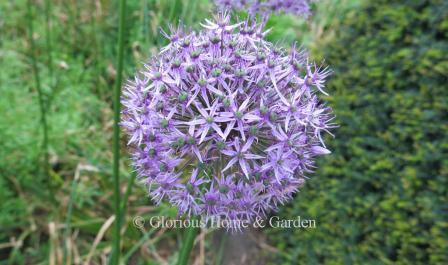 Allium 'Gladiator'
Allium 'Gladiator'Allium giganteum, giant onion, Zones 4-8. Decorate your spring garden with these huge, baseball size heads of tightly-packed purple florets. Blooming in late spring, giant onions will tower over your border from 4’ to even 6’ in the right conditions. Like other ornamental onions, the foliage emerges in early spring and begins to die back as the flowers open, so plant other herbaceous perennials around their feet to hide the dying foliage such as salvias, catmint, foxgloves or irises. It may be tempting to cut the foliage off, but allow it to mature naturally as it is storing food for next year’s bloom. Grow in full sun with good drainage.
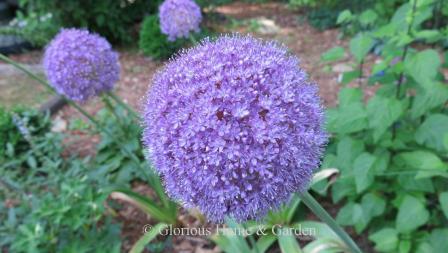 Allium giganteum
Allium giganteumAllium hollandicum ‘Purple Sensation,’ ornamental onion, Zones 4-8. Gorgeous, dramatic color a little more on the red-violet side, ‘Purple Sensation’ is a standout in the spring garden. The flowerheads are a little smaller (about 4-5”) than ‘Ambassador’ and the like, and the stems are a little shorter (24-30”), but the color gives them a great presence. Also known as A. aflatunense ‘Purple Sensation.’
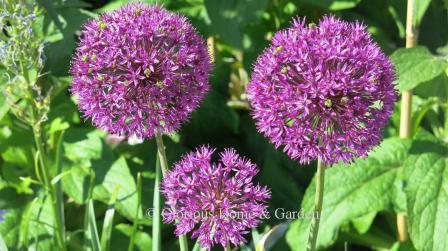 Allium hollandicum 'Purple Sensation'
Allium hollandicum 'Purple Sensation'Allium karataviense, Turkistan onion, Zones 4-8. This allium has attractive wide blue-green leaves from which arises a short stalk bearing a large ball about 3-6”of white to pale pink florets. Best grown in full sun in a sandy, well-drained soil.
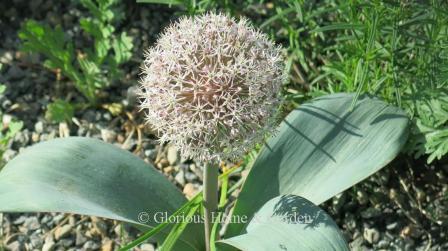 Allium karataviense
Allium karatavienseAllium moly, yellow garlic or lily leek, Zones 3-9. This beautiful bright yellow allium makes a refreshing contrast to the typical purple or white ones, and combines well with them. A. moly will make a nice clump with multiple flowerheads, and it is edible, making it an nice addition to the vegetable or herb garden. And like other alliums, deer won’t touch it.
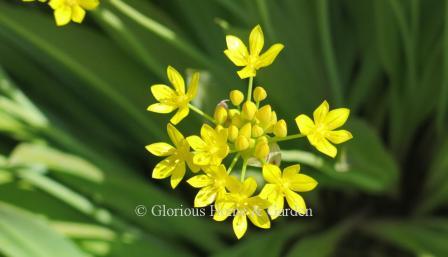 Allium moly
Allium molyAllium nigrum, black garlic, Zones 5-8. This ornamental onion, also known as Allium
multibulbosum, has 2-3” wide flat-bottomed umbels that open white with
green "eyes" on a stem up to 24”. Blooms
late spring into early summer. There are
a couple of Allium nigrum cultivars including ‘Pink Jewel’ with pale
pink flowers; and ‘Silver Spring’ with pale pink flowers that fade to white,
but with striking darker raspberry centers.
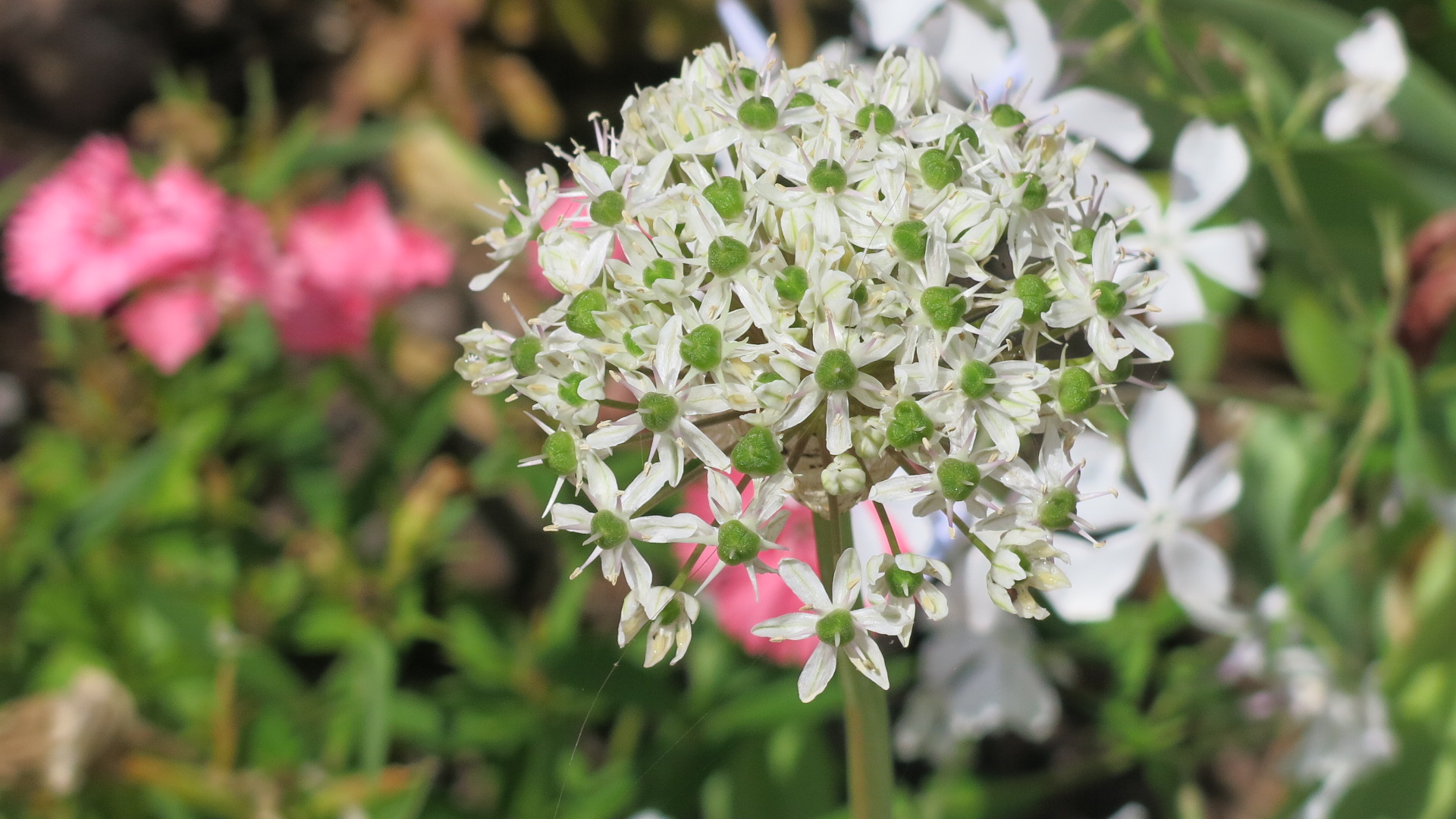 Allium nigrum
Allium nigrum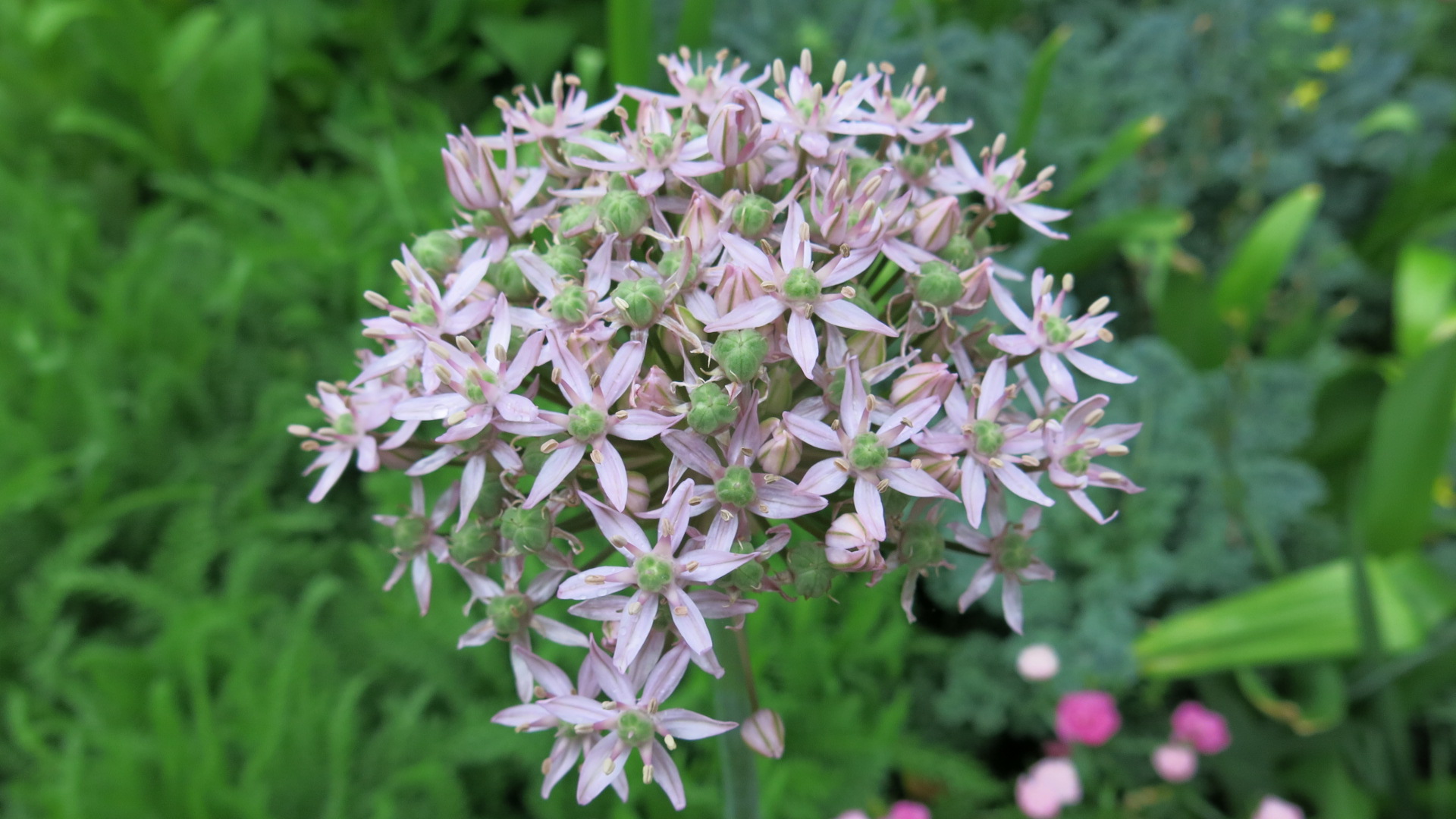 Allium nigrum 'Pink Jewel'
Allium nigrum 'Pink Jewel'Allium shubertii, tumbleweed onion, Zones 5-9. This one is astonishing! It looks for all the world like a fireworks display with large, airy heads up to 16" in the right conditions. Some of the flowers form a ball close to the center like a typical ornamental onion, but the rest zoom out on long stems to create the "explosion." The dried seed heads remain interesting in the garden and can be used for decorations.
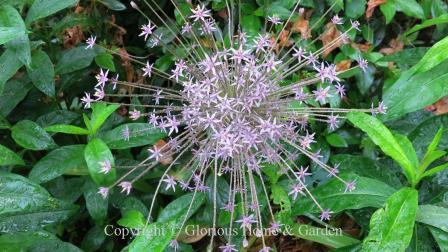 Allium shubertii
Allium shubertiiAllium stipitatum, ornamental garlic or Persian shallot, Zones 4-8. This is a stunning allium to grow in a mixed herbaceous border among perennials. Like most of the alliums, the foliage will begin to die back before the flowers are finished, so it is a good idea to plant them among perennials to hide the dying foliage. The foliage, however, must not be removed until it has completely died away so it can make food for next year’s bloom. The tall, slender stalks can reach 3-4’, but the dense flowerhead is not as large, as say, ‘Ambassador’ above, or some of the other hybrids. Leaving the dried flowerheads on the plants continues to provide interest in the garden even after the color fades. Other varieties include ‘Mount Everest’ and ‘White Giant,’ white, and ‘Violet Beauty,’ violet.
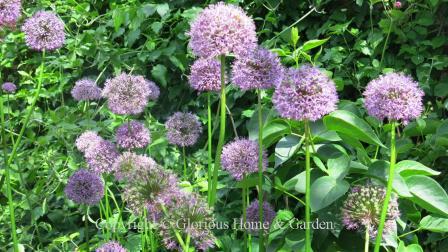 Allium stipitatum
Allium stipitatum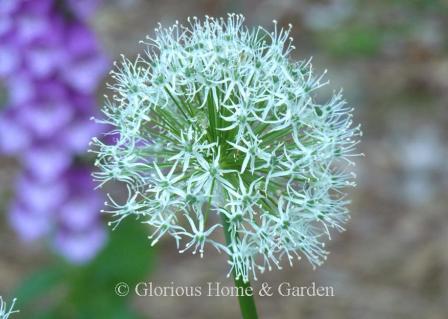 Allium stipitatum 'Mount Everest'
Allium stipitatum 'Mount Everest'Allium uniflorum, ornamental onion, single-leaf onion, Zones 5-8. This California native is a smaller ornamental onion, growing to about 16,” and in spite of the common name, does have more than one leaf. The lavender-pink flowers appear in late spring to early summer. Preferring well-drained soil and full sun, these bulbs will go dormant in the summer and prefer conditions on the dry side.
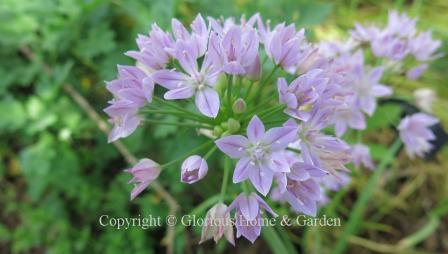 Allium unifolium
Allium unifoliumAnemones
Anemone apennina, Apennine or Italian windflower, Zones 6-9. These charming spring bulbs are very effective planted in large drifts to carpet the ground in a woodland garden. They are long-lasting, whitish, daisy-like flowers rise above the foliage about 6-9". They like a dry dormancy in the summer, so no supplemental watering is needed.
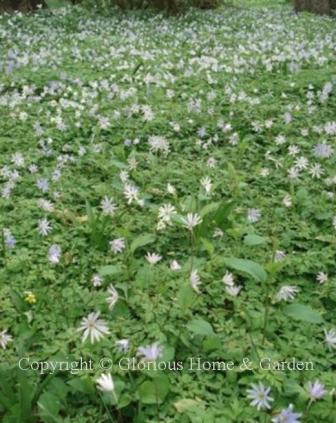 Anemone apennina
Anemone apenninaAnemone blanda, Grecian windflower, Zones 4-7. Grecian anemones are similar to the Apennine, but are blue, white or pink, and a little shorter at 3-6". Treat them the same way--plant them in drifts in open woodland areas or under flowering trees in humusy, well-drained soil.
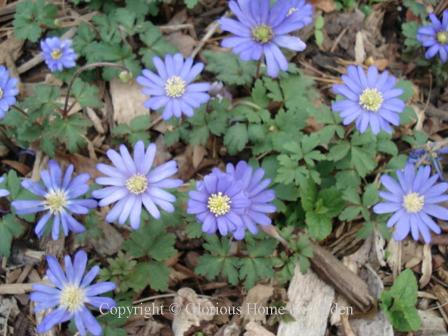 Anemone blanda
Anemone blandaAnemone coronaria, poppy anemone, Zones 6-9. Poppy anemones have larger flowers (3") and are taller (12-18") than A. apennina or A. blanda, and come in clear, bright colors of red, blue, purple, white and magenta with black centers and attractive ferny foliage. Unlike the other two species which only bloom in spring, you can plant tubers of A. coronaria in fall for spring blooms, in spring for summer blooms, and again in summer for fall blooms. Very showy in the garden and great for containers, too. Varieties include 'The Bride,' single white; ‘Bicolor' single red and white; ‘The Governor,’ red; 'Mr. Fokker,' single violet-blue;' 'Lord Lieutenant,' double violet-blue; 'Mount Everest,' double white; and 'Sylphide,' single rose-violet.
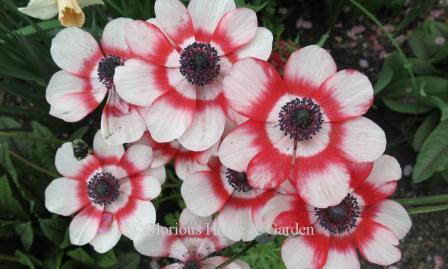 Anemone coronaria 'Bicolor'
Anemone coronaria 'Bicolor'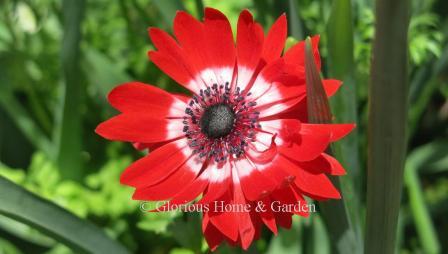 Anemone coronaria 'The Governor'
Anemone coronaria 'The Governor'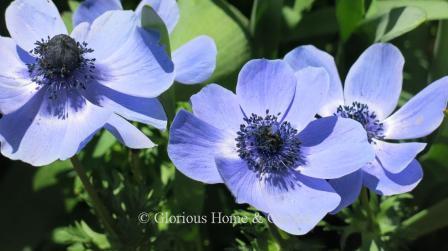 Anemone coronaria 'Mr. Fokker'
Anemone coronaria 'Mr. Fokker'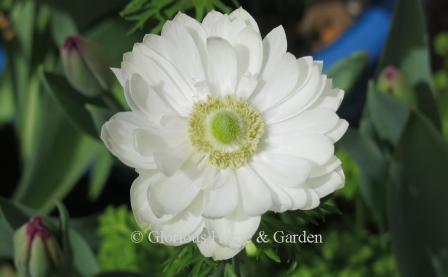 Anemone coronaria 'Mount Everest'
Anemone coronaria 'Mount Everest'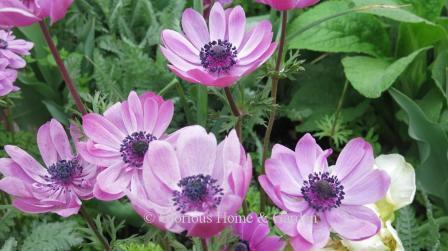 Anemone coronaria 'Sylphide'
Anemone coronaria 'Sylphide'Arisaema sikokianum, gaudy Jack, Zones 5-7. Related to our woodland wildflower, Jack-in-the-Pulpit, this Jack is larger and showier--hence the nickname "gaudy Jack." The contrast of striped hood and pure white center is striking.
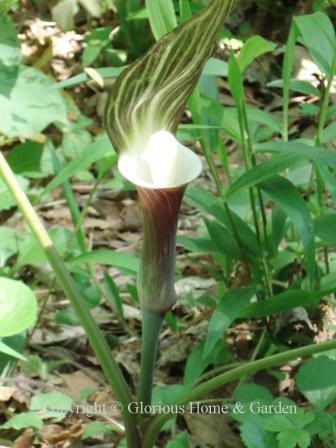 Arisaema sikokianum
Arisaema sikokianumBellevalia paradoxa, bellevalia, Zones 7-9. Often mistaken for grape hyacinths, which they resemble, bellevalias bloom at the same time from tightly clustered racemes of buds that open from the bottom over a goodly period of time.
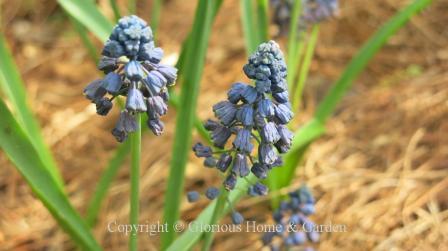 Bellevalia paradoxa
Bellevalia paradoxaBletilla striata, Chinese ground orchid or hardy orchid, Zones 5-9. You wouldn't think that such a charming, apparently fragile little orchid could survive out-of-doors, but it does. Growing from underground tubers called pseudobulbs, these spring bulbs prefer moist humusy soil and a partially shady location making them good companions for hostas, Iris cristata, epimediums and heucheras. The narrow, pleated leaves are a good textural accent throughout the summer, and the elongated seedpods (also pleated-looking) are also interesting. The purple color is the most common, but there is a white form called 'Alba,' and a variegated form 'Albostriata.'
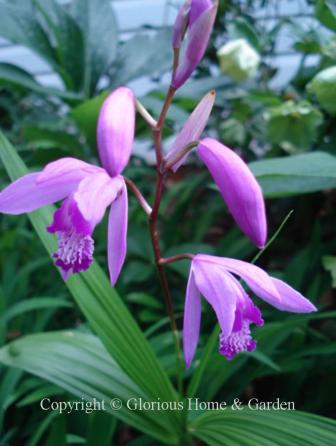 Bletilla striata
Bletilla striataCamassia leichtlinii, Leichtlin camass, Zones 5-9. This North American spring bulb is becoming more and more popular in residential gardens. This is a large plant that can grow 3-4' tall. Plant it in groups in the border in full sun and provide ample moisture during the blooming season. Flowers can be blue, purple, white or cream.
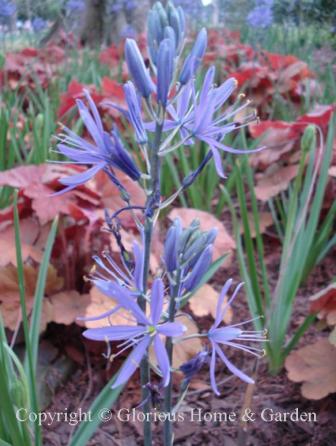 Camassia leichtlinii 'Caerulea'
Camassia leichtlinii 'Caerulea'Chionodoxa forbesii, glory-of-the-snow, Zones 4-8. These small blue flowers are so eager to put on their display that they will often bloom through patches of snow in late winter or early spring. They are charming planted under trees or shrubs or through grass where they can bloom before the emerging leaves of the trees block the sun. Where happy, they will self-seed and carpet the ground in blue increasing the show every year. And they are deer resistant. Commonly blue with white hearts, there are also white and pink forms.
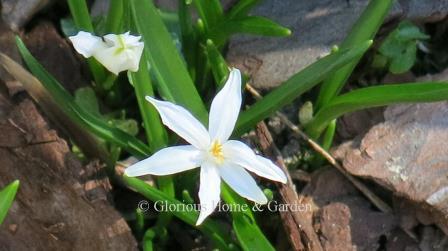 Chionodoxa forbesii 'Alba'
Chionodoxa forbesii 'Alba'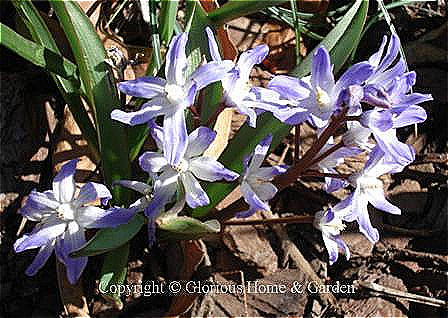 Chionodoxa forbesii 'Blue Giant'
Chionodoxa forbesii 'Blue Giant'Convallaria majalis, lily-of-the-valley, Zones 3-8. Lily-of-the-valley is treasured for its sweetly-scented dainty nodding white bells that bloom in spring. It grows best in a partly shady to shady area where its rhizomes, called pips, can spread. It makes a lovely ground cover for a woodland area, and as all parts are quite poisonous, is avoided by deer and other woodland creatures. In addition to the typical white, there is also a pink form, C. majalis var. rosea. Added interest comes from bright orange-to-red berries in the fall.
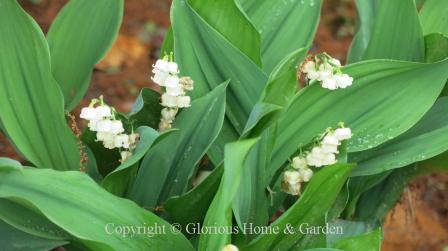 Convallaria majalis
Convallaria majalisCrocus vernus, Dutch hybrid crocus, Zones 3-8. Many of our favorite spring flowering crocuses are hybrids of C. vernus and other species. They emerge in late winter to spring, sometimes through patches of snow, cheerily announcing the new season. The corms can be planted close together and about 4" deep--so do plant them in substantial groups for the most impact. They look lovely planted en masse in lawns or under trees, but if you are going to plant them in grass remember that you cannot mow that area until the crocus foliage has completely withered so it can store food for next year's bloom. Crocuses come in white, yellow, blue and purple and some favorite cultivars are 'Golden Yellow,' yellow; 'Jeanne d'Arc,' white; 'King of the Striped,' violet with darker striping; 'Remembrance,' dark blue; 'Twilight,' deep violet-blue; and 'Vanguard', purple inside with lighter grayish-mauve outside.
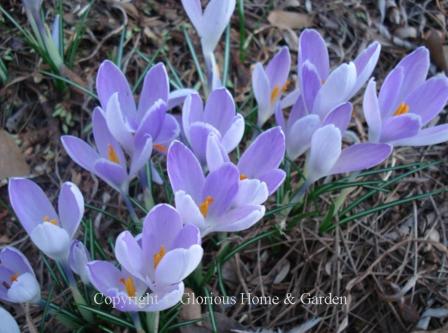 Crocus 'Vanguard'
Crocus 'Vanguard'Erythronium x ‘Pagoda,’ trout lily or dog-tooth violet, Zones 3-8. ‘Pagoda’ is a hybrid between two native American species and thus is endowed with hybrid vigor. This is a charming plant to add to a woodland garden in combination with violets, ferns, hellebores, Virginia bluebells, bleeding hearts, trilliums, and Solomon’s seals, as well as other small bulbs such as grape hyacinths and wood hyacinths. Grown from a bulb planted in the fall, the glossy leaves emerge in spring followed by dainty yellow lily-like flowers (and indeed it is in the lily family) with recurved petals, often several per stem. As a spring ephemeral, it will go dormant not long after flowering to re-emerge the following springs, so be sure to mark its location. Best grown in semi-shade in rich, moist, humusy soil.
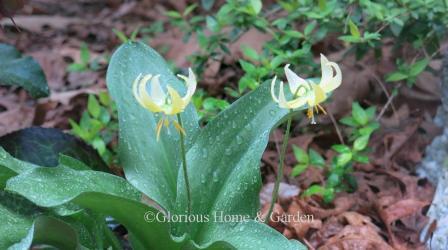 Erythronium x 'Pagoda'
Erythronium x 'Pagoda'Fritillaria imperialis, crown imperial, Zones 5-9. Imperial indeed, these majestic blooms rise on 2'-3' stalks seeming to gaze on their subjects below. Nodding bells of yellow or orange encircle the top of the stem and are crowned with a pineapple-like tuft of leaves. Plant these large bulbs about 12" deep in rich, well-drained soil in full sun. 'Maxima Lutea,' yellow or 'Maxima Rubra,' red, are the best-known forms.
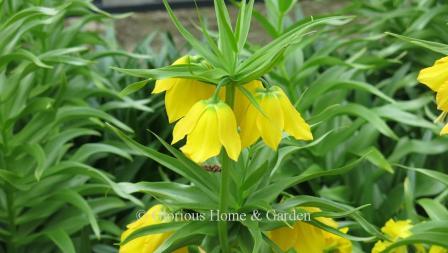 Fritillaria imperialis 'Maxima Lutea'
Fritillaria imperialis 'Maxima Lutea'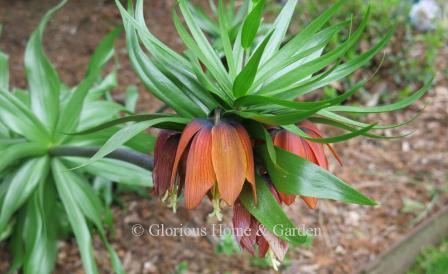 Fritillaria imperialis 'Maxima Rubra'
Fritillaria imperialis 'Maxima Rubra'Fritillaria meleagris, snake's head fritillary or guinea hen flower, Zones 3-8. The checkerboard pattern of the nodding purple and white blooms is one of the most distinctive in nature. Growing about a foot tall on slender stalks with grassy foliage, this European native is found naturally in damp meadows in full sun and prefers the same conditions in the garden. Plant as soon as available in the fall and do not allow the fragile bulbs to dry out. Plant together in clumps where they can stay undisturbed and they will self seed if happy.
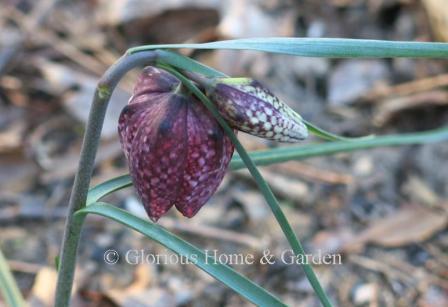 Fritillaria meleagris
Fritillaria meleagrisGladiolus communis ssp. byzantinus ‘Cruentus,’ sword lily, Zones 5-10. I fell in love with this hardy glad on a trip to England, and of course I had to have some. Such an outstanding color in the spring garden! Well, I ordered them from a reputable source and eagerly anticipated the color—only to have them bloom a pallid, washed-out, non-descript pink, not this rich magenta verging on purple. I learned that inferior bulbs are common and it is hard to find the real thing. www.oldhousegardens.com is a good source. Plant the bulbs in the fall for late spring, early summer bloom (depending on location), and make note of where they are since they go dormant in the summer.
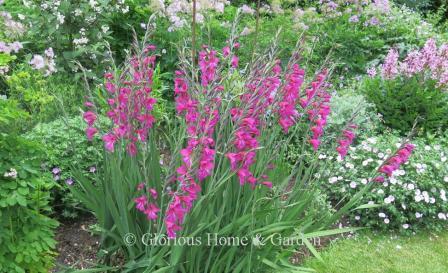 Gladiolus communis ssp. byzantinus 'Cruentus'
Gladiolus communis ssp. byzantinus 'Cruentus'Hyacinthoides hispanica, Spanish bluebell or wood hyacinth, Zones 4-7. A lovely choice for a woodland garden, these spring bulbs bear 12-to-15 blue, pink or white bell-shaped flowers encircling the stem (unlike H. non-scripta below which flowers on one side of the stem). Also, their petals do not recurve as much as the English bluebells nor are they as fragrant. Good cultivars are 'Excelsior,' blue; var. rosea,' pink; and 'White City,' white.
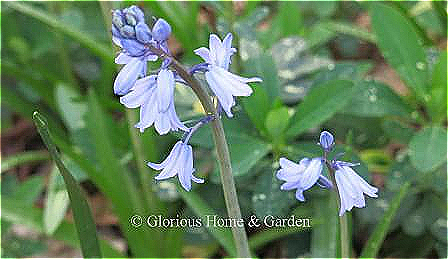 Hyacinthoides hispanica 'Excelsior'
Hyacinthoides hispanica 'Excelsior'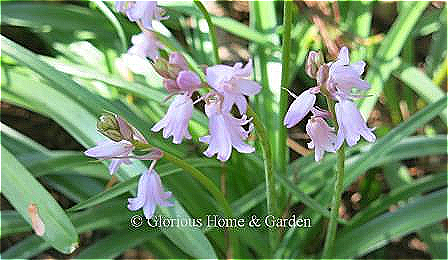 Hyacinthoides hispanica var. rosea
Hyacinthoides hispanica var. roseaHyacinthoides non-scripta, English bluebell, Zones 5-7. This is the flower that carpets the famed "bluebell woods" of England in spring to enchanting effect. The slender stalk has flowers on one side of the stem only and gently curves seeming to bow under the weight of the blooms. Each violet-blue bell-shaped flower has petals that scroll up at the tips. Very charming, and fragrant as well. You can start your own bluebell wood by planting under trees in partial shade where they can naturalize undisturbed. In addition to the blue, there are white 'Alba,' and pink 'Rosea,' forms.
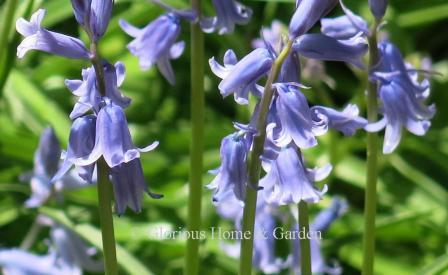 Hyacinthoides non-scripta
Hyacinthoides non-scripta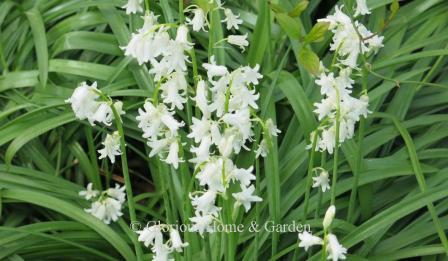 Hyacinthoides non-scripta 'Alba'
Hyacinthoides non-scripta 'Alba'Hyacinthus orientalis, hyacinth, Zones 3-7. Intensely fragrant, the compact flower spikes are rather formal in appearance, but make a great color impact in the garden. They are also great for forcing indoors for fragrance and the promise of spring in the winter. Plant them outdoors in good, well-drained soil in a few groups or clumps, or in pots where they can be enjoyed for their fragrance. These spring bulb prefer cooler climates, so in the South they are best treated as annuals. There is a wide range of colors and cultivars to choose from such as 'Apricot Passion,' apricot; ‘Blue Jacket’; blue; ‘Carnegie,’ white; 'City of Haarlem,' pale yellow; 'Delft Blue,' light blue; 'Fondant,' light pink; 'Jan Bos,' deep pink; 'Pink Pearl,' pink; ‘Purple Sensation,’ purple; ‘Purple Star,' mauve-purple and blue; ‘Royal Navy,’ deep blue; and ‘Yellow Queen,’ yellow.
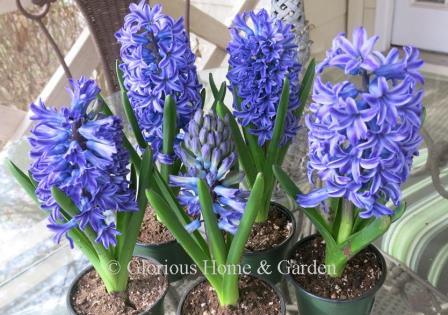 Hyacinthus orientalis 'Blue Jacket'
Hyacinthus orientalis 'Blue Jacket'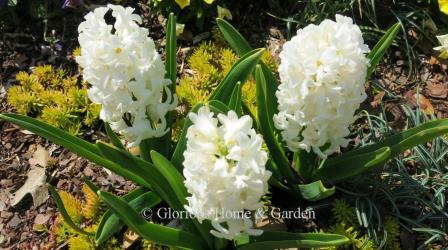 Hyacinthus orientalis 'Fairy White'
Hyacinthus orientalis 'Fairy White'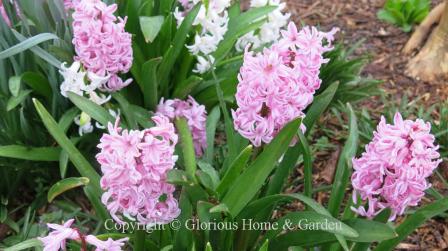 Hyacinthus orientalis 'Fondant'
Hyacinthus orientalis 'Fondant'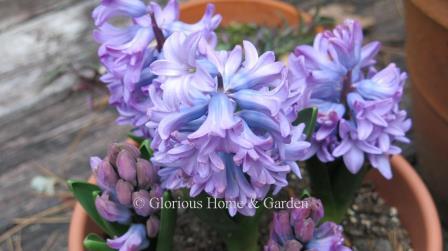 Hyacinthus orientalis 'Purple Star'
Hyacinthus orientalis 'Purple Star'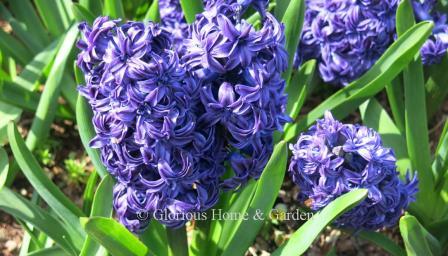 Hyacinthus orientalis 'Royal Navy'
Hyacinthus orientalis 'Royal Navy'Ipheion uniflorum, spring starflower, Zones 5-9. These little spring bulbs are great for naturalizing in woodlands as they multiply quickly. The star-shaped blooms have six pointed petals and a deep center cup from which the yellow stamens peek. The species is variable in color from bluish-white to soft violet, but there are selected cultivars for more uniform color such as 'Alberto Castillo,' white; 'Rolf Fiedler,' a deeper violet-blue with rounder petals; and 'Wisley Blue' with larger flowers of mid-blue.
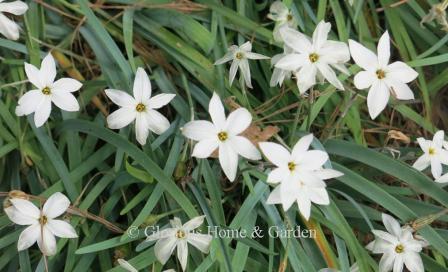 Ipheion uniflorum 'Alberto Castillo'
Ipheion uniflorum 'Alberto Castillo'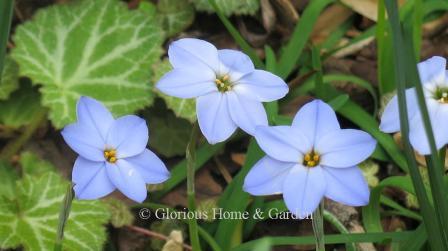 Ipheion uniflorum 'Rolf Fiedler'
Ipheion uniflorum 'Rolf Fiedler'irisIris X hollandica, Dutch iris hybrids, Zones 5-9. Dutch irises were created in the early 20th c. in Holland from crosses between several species of irises mainly for the cut flower market. True bulbous irises, Dutch irises are easy to grow and extend the iris season as they bloom after the tall bearded irises. The tall, slender leaves appear in winter and bloom in mid to late spring; after flowering the leaves die back until the next winter. Varieties include 'Alaska,' white; 'Autumn Princess,' purple-ish standards with yellow/bronze falls; 'Carmen,' white with lavender and yellow blotch; 'Eye of the Tiger,' purple standards and bronze falls with yellow blotch ; 'Mystic Beauty,' blue standards with yellow falls; 'Professor Blaauw,' violet blue w/yellow blotch on falls; 'Red Ember,' blue-violet standards with rosy falls;'Rosario,' pink-violet; 'Telstar,' deep blue; 'Wedgwood,' blue.
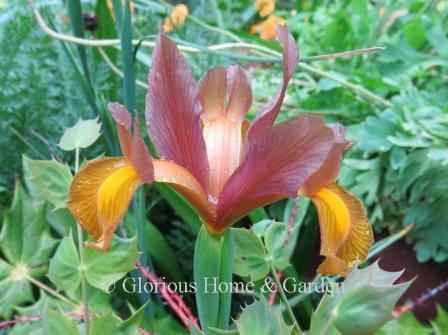 Iris hollandica 'Autumn Princess'
Iris hollandica 'Autumn Princess'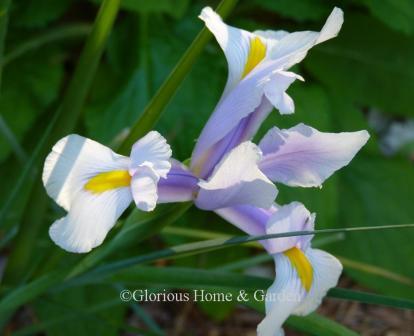 Iris hollandica 'Carmen'
Iris hollandica 'Carmen'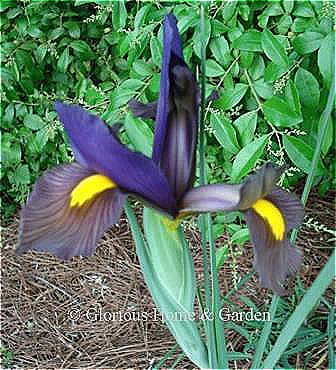 Iris hollandica 'Eye of the Tiger'
Iris hollandica 'Eye of the Tiger'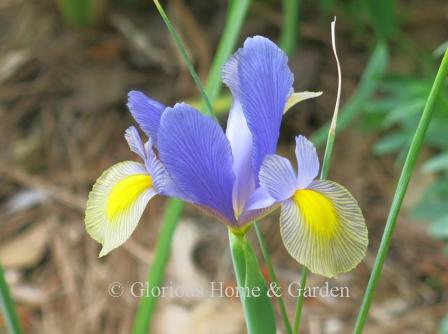 Iris hollandica 'Mystic Beauty'
Iris hollandica 'Mystic Beauty'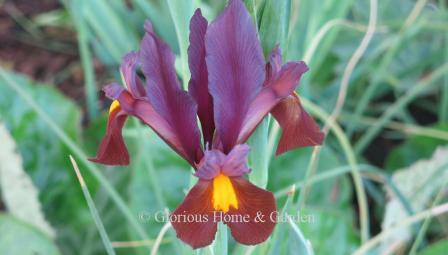 Iris hollandica 'Red Ember'
Iris hollandica 'Red Ember'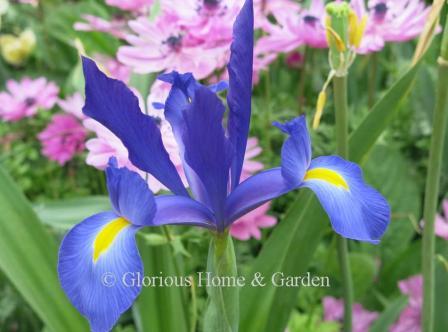 Iris hollandica 'Telstar'
Iris hollandica 'Telstar'Leucojum aestivum, summer snowflake, Zones 4-8. Pure white bells with a green splotch at the tip of each petal, the so-called "summer snowflake" is actually more of a mid-to-late spring bloomer (depending where you live) and flowering after its L. vernum (spring snowflake) cousin. Taller also than L. vernum, summer snowflake at about 20", is effective planted in generous clumps and in combination with narcissus and tulips. 'Gravetye Giant' (shown) is a particularly good cultivar with larger flowers than the species.
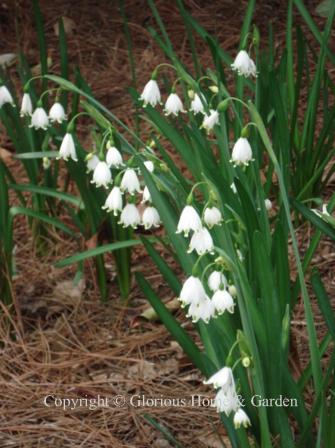 Leucojum aestivum 'Gravetye Giant'
Leucojum aestivum 'Gravetye Giant'Muscari (Grape Hyacinths)
The pure blues of grape hyacinths pair beautifully with the whites, yellows and pinks of daffodils and tulips. Plant these little spring bulbs in drifts for a carpet of color. The foliage can appear as early as late autumn and remains evergreen throughout the winter. In addition to the common blue types, lovely as they are, there is a surprising diversity of species and hybrids to choose from.
Muscari armeniacum, Armenian grape hyacinth, Zones 4-8. A deep cobalt blue, the Armenian grape hyacinth grows about 6" h. Relatively inexpensive, plant these in drifts to naturalize in woodland areas as they multiply easily.
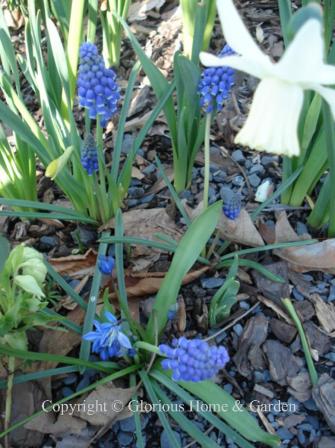 Muscari armeniacum
Muscari armeniacumMuscari armeniacum 'Siberian Tiger' a white variety of grape hyacinth
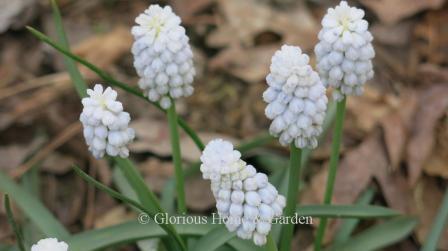 Muscari armeniacum 'Siberian Tiger'
Muscari armeniacum 'Siberian Tiger'Muscari armeniacum 'Valerie Finnis,' beautiful pale lavender-blue very tightly packed
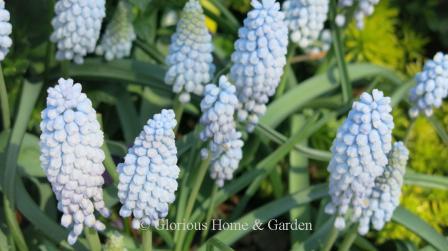 Muscari armeniacum 'Valerie Finnis'
Muscari armeniacum 'Valerie Finnis'Muscari aucheri 'Dark Eyes' dark blue with white edge
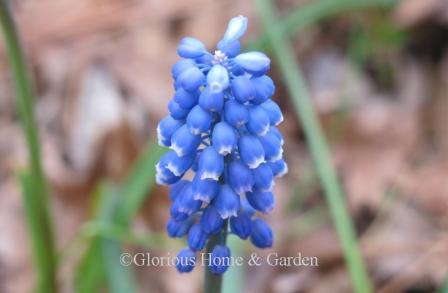 Muscari aucheri 'Dark Eyes'
Muscari aucheri 'Dark Eyes'Muscari aucheri 'Ocean Magic,' has a three-tone effect with dark blue changing to paler blue and finally capped with white
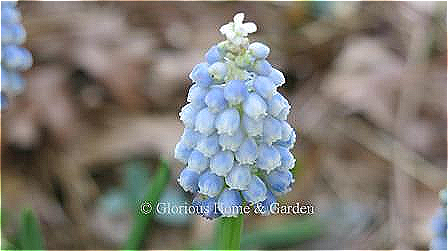 Muscari aucheri 'Ocean Magic'
Muscari aucheri 'Ocean Magic'Muscari aucheri 'White Magic,' green buds open to white from the bottom up
Muscari azureum, azure grape hyacinth, Zones 5-8. Pale blue with flowers that open wider than most other grape hyacinths
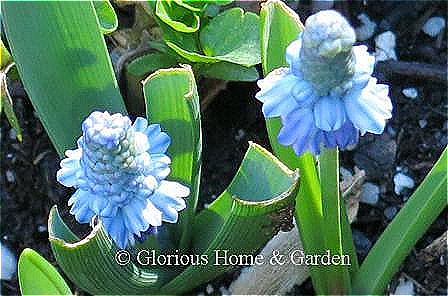 Muscari azureum
Muscari azureumMuscari botryoides, common grape hyacinth, Zones 2-8. I love these little charmers of pure blue with their tight grape-like clusters of buds that open from the bottom. They are perfect to plant in masses as a blue carpet for taller daffodils to rise above. 'Album' is the white variety
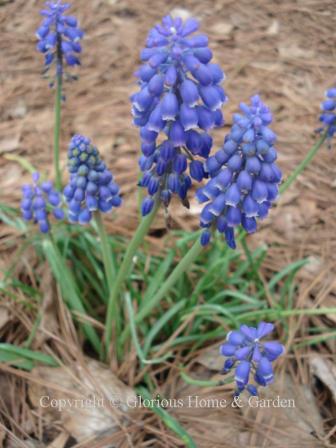 Muscari botryoides
Muscari botryoidesMuscari comosum 'Plumosum,' the feather or tassel hyacinth, Zones 4-8. Very different is this muscari with its airy plumes of reddish-violet.
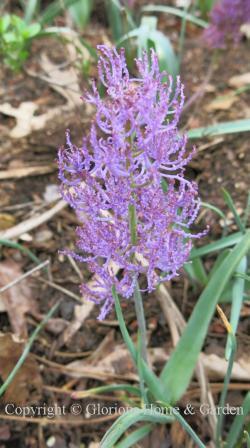 Muscari comosum 'Plumosum'
Muscari comosum 'Plumosum'Muscari latifolium, two-tone with darker violet-blue below and lighter blue above
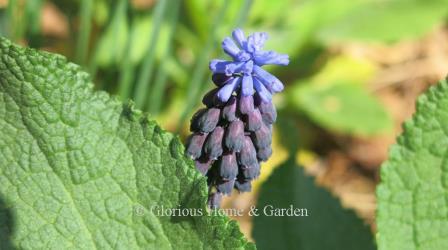 Muscari latifolium
Muscari latifoliumMuscari latifolium 'Grape Ice' also has a two-tone effect with dark purple at the bottom topped off with a white cap.
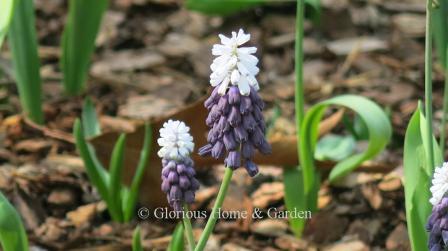 Muscari latifolium 'Grape Ice'
Muscari latifolium 'Grape Ice'Muscari macrocarpum, 'Golden Fragrance,' Zones 7-9, yellow capped with violet
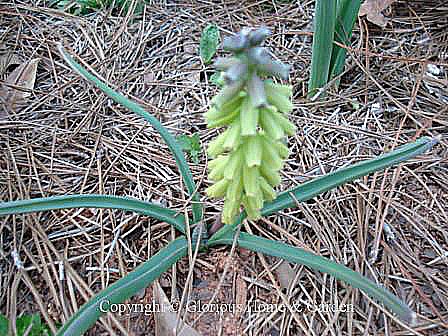 Muscari macrocarpum 'Golden Fragrance'
Muscari macrocarpum 'Golden Fragrance'Muscari neglectum, Southern grape hyacinth, starch or blue-bottles, Zones 6-10. Dark navy blue flowers rimmed with white distinguish this classic Southern grape hyacinth.
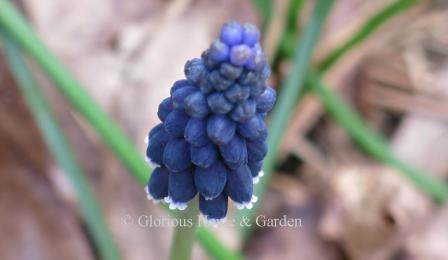 Muscari neglectum
Muscari neglectumNarcissus (Daffodils and Jonquils)
Dispel the gloom of late winter and welcome spring with the brightness and charm of daffodils in shades of pure yellow, white, and soft pinks. There are many varieties and types to choose from to span almost the entire spring season from the earliest eager-to-bloom jonquils to the trumpet hybrids of the main season. Easy to grow and deer-resistant, daffodils are great for naturalizing or adding to beds and borders. Plant these large spring bulbs in the fall in drifts under deciduous trees where they will get spring sun, in a swath in a lawn, in groups in a border, or in containers on the patio. They are classified into 13 divisions depending on their characteristics. Click here for classifications and more examples of gorgeous daffodils! 'Apricot Whirl,' below, is representative of the split-cupped collar type.
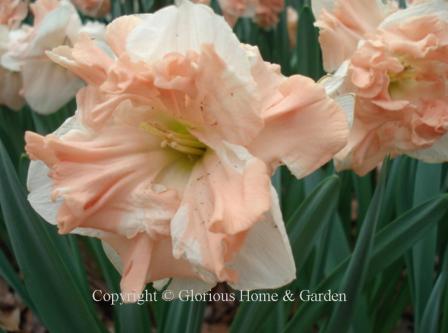 Narcissus 'Apricot Whirl'
Narcissus 'Apricot Whirl'Nectaroscordum siculum, Sicilian honey garlic or
honey bells, Zones 5-10. This is a
charming spring bulb that sends up tall stalks of about 2-3’ before splitting a
papery sheath to release an umbrella of little purple, green and cream pendant
bells. The foliage is strappy and smells
of garlic when crushed. An allium
relative, they bloom for me at the same time as my ‘Ambassadors’ and A. christophii. Plant in the fall about 3” deep in groups
about 9-12” apart, and they will self-seed where happy.
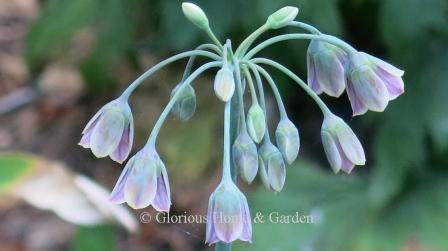 Nectaroscordum siculum
Nectaroscordum siculumOrnithogalum umbellatum, Star-of-Bethlehem, Zones 4-9. Star-of-Bethlehem is a mid-to-late spring bloomer that is very easy to establish--so easy in fact that you may find yourself removing unwanted plants that may pop up all over the garden. But as charming as they are with the greenish-white star-shaped flowers rising above their mound of grass-like foliage, you may not mind at all, and simply dig up unwanted clumps to share with friends.
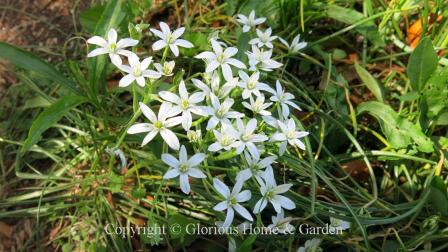 Ornithogalum umbellatum
Ornithogalum umbellatumOxalis regnellii ‘Atropurpurea’, purple oxalis, false shamrock, or wood sorrel, Zones 6-11. The leaves on this clover look-alike are amazing—each triangular leaf is so dark green on the edges as to look almost black and with butterfly-shaped purple blotches in the center. Great as a ground cover in a woodland garden. Worth growing these spring bulbs (actually tubers) for the leaves alone, but the white-to-pinkish flowers are a bonus blooming in spring and sporadically in summer The plants go dormant in winter and excellent drainage is imperative for survival.
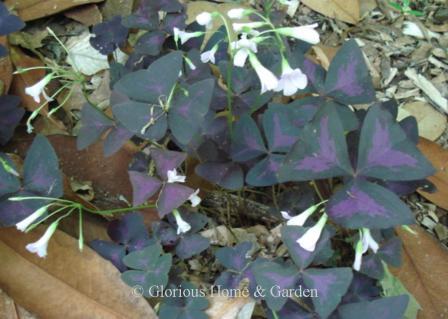 Oxalis regnellii 'Atropurpurea'
Oxalis regnellii 'Atropurpurea'Puschkinia scilloides var. libanotica, striped squill, Zones 4-8. This is a delightful late-winter-to-early-spring flowering bulb in the palest icy bluish-white with a darker blue stripe down the center of each petal. Hailing from the Caucasus and Middle East, they resemble squills, hence the name, but are different enough to rate their own genus. At only 4-6" tall, these small bulbs should be planted in clumps to give them more presence. A dark background would show them off well. Try planting them in clumps where you can appreciate them or at the edge of a woodland or in short turf along with Fritillaria meleagris, Iphieon uniflorum, Scilla siberica, Chionodoxa forbesii, and Muscari botryoides. They like moist conditions during their growing season, and drier undisturbed conditions during their dormant period. Plant them in sun or partial shade about 2-4" deep and 4" apart. They are very hardy and will naturalize freely where happy.
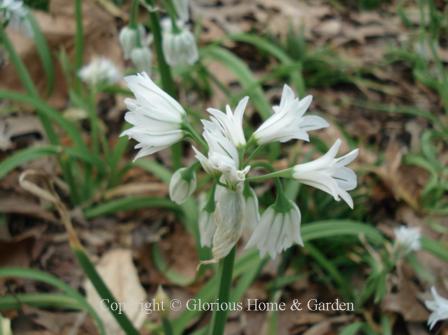 Puschkinia scilloides var. libanotica
Puschkinia scilloides var. libanoticaScilla peruviana, Peruvian squill, Zones 7-10. Peruvian squills are delightful spring bulbs that deserve to be used more widely. Blooming in late spring to early summer, a short stalk rises from a rosette of flattened leaves to about 6-12″ from which a ball of tightly-packed violet-blue flowers opens from the bottom up in a cone to spherical shape. The center looks darker with the unopened buds. This is one spring bulb that can tolerate some shade. Unusual and interesting.
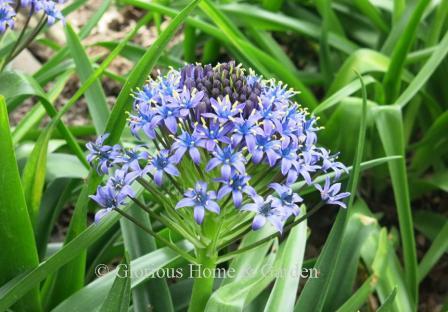 Scilla peruviana
Scilla peruvianaScilla siberica, Siberian squill, Zones 2-7. These charming little spring bulbs in a beautiful shade of blue are marvelous to naturalize under spring blooming trees or woodlands where they will multiply and carpet the ground along with clumps of other small bulbs like puschkinias, crocuses, ipheions and glory-of-the-snow, as well as perennials like Virginia bluebells, trilliums, epimediums and bleeding hearts.
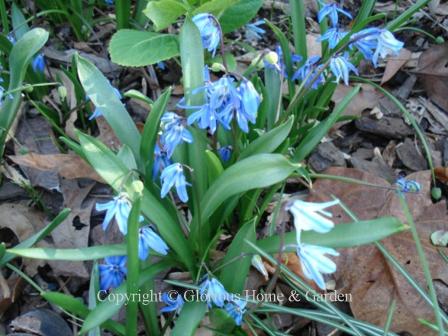 Scilla siberica
Scilla sibericaTulipa (Tulips)
Tulips are the classic spring bulbs. Their elegant form, beautiful colors, and blooming times make them essentials. Like daffodils, tulips are arranged in divisions based on their characteristics.
Please click this link for the tulip classifications and examples. 'Happy Family' (below) is an example of the Multi-Flowering class.
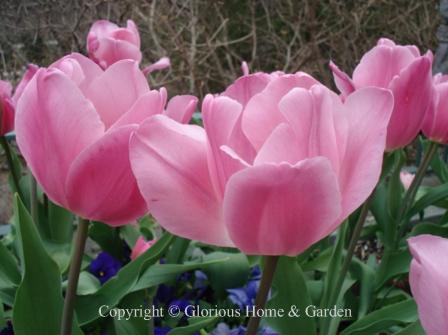 Tulip 'Happy Family'
Tulip 'Happy Family'Zephyranthes atamasco, Atamasco lily or rain lily, Zones 7-10. Unlike most other zephyr lilies, this one blooms in the spring. Leaves emerge in winter, followed by flowers in spring, especially after a good rain. Pinkish buds unfurl to pure white with a green throat. Native to the southeastern U.S.
 Zephyranthes atamasco
Zephyranthes atamascoPlant of the Month

Ilex verticillata
Winterberry holly
Updated new USDA Plant Hardiness Zone Map 2023.